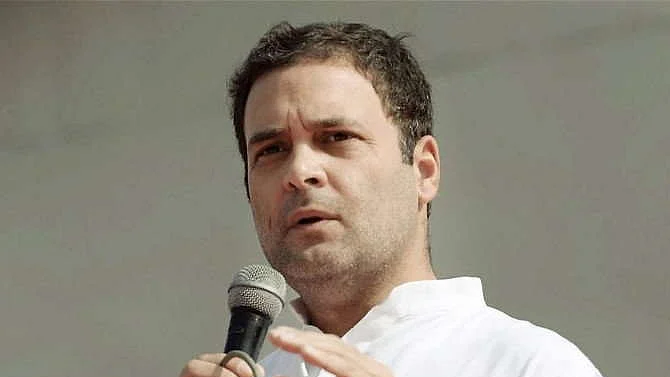What is it about Manasarovar that has evoked such a response from BJP?
BJP spokesperson’s criticism of Rahul’s professed veneration for Shiva had the mark of institutional priesthood that his Party seems to have appropriated for performing all traditional Hindu rituals

On April 29th this year, addressing a rally at the Ramlila Maidan in New Delhi, Congress President Rahul Gandhi announced that he was planning to go on a personal pilgrimage to the holy Kailash Mansarovar region, the abode of lord Shiva and his consort Parvati, according to Hindu belief. This, he said was his way of offering his thanks to Lord Shiva for saving his life when a plane he was flying in, mysteriously developed a serious snag and could well have crashed. At that point it suddenly flashed in his mind he said, that he must visit Kailash Mansarovar. So on August 31st, he left on a two week Yatra via Nepal and Lhasa, while the BJP spokesperson fulminated against the route chosen by Mr Gandhi that would take him into China controlled territory. Political tensions between India and China had led to closing the pilgrimage route between 1954-78. But it is now fully functional . In 1997 a small medical centre was also built here to cater to the pilgrims’ needs by the Swiss Ngari Korsum Foundation.
The history of pilgrimages to Mount Kailash and the Mansarovar lake goes back to thousands of years. The Mansarovar lake is among the five holiest lakes or Panch Sarovar: Mansarovar, Bindu, Pampa, Narayan and Pushkar. The Mahabharata describes Kailash as the monarch of all mountains, a golden lotus that is an eternal refuge of asetics and a source of rivers that are the elixir of life. What the Mahabharata tells us, is symbolically very true. This area is the fountainhead from which stems the virtually entire river system of the Indo Gangetic plains. The four great rivers : the Indus, Satluj, Brahmaputra and Ghaghra all have their source here among the holy snow covered region.
The Tibetan name for Mount Kailash, Gangs Rinpoche( Precious jewel of snows), sums up the sentiment associated with the mountain beautifully. The has also been a holy spot of pilgrimage for followers of Bon Po, the pre Buddhist Tibetan religionfounded by TorpaShenab in the area. Followers of Bon Poworship a deity, Zhang ZhungMeri.
The Buddhists believe that the Buddha (Anavatapta,)visited the area several times and meditated here. The Vajrayani Tantric sect of Buddhism was officially brought in to Tibet by the Buddhist sage Padmasambhava around 7th - 8th century. There are legends about him defeating the leader of the Bon Po sect in a duel of sorcerers, and christening a local mountain Bon ri with a fistful of snow , declaring it magnanimously as abode of his defeated but worthy adversary. Thus creating a peaceful togetherness of religions. The area is also sacred to the followers of Jainism. They refer to Mount KailashMeruParvat and believe their first Teerthankara Rishabhdevji visited the spot and attained his Nirvana here at the mountain known as Ashtpad.
Interestingly, it is said that the 14th Dalai Lama saw three syllables reflected in the Mansarovarlake denoting the province, the district and the monastery where they could locate the present Dalai Lama.
The phenomena of personal and political innuendos couched now in religious terminology, and then suddenly slipping into gross political name calling, remains a compelling study in the psychology of wielders of political power in India.
Next to the mount Kailash lies the only sweet water lake in the region, the Mansarovar, fed by the glaciers at the mountain.At an elevation of 15,060feet, it has a circumference of 410 kilometers. This is connected with another lake the Rakshas Tal which is a salt water lake. Legend has it that this is where the demon king Ravana of Lanka meditated to placate Lord Shiva. This lake has no aquatic or marine life and locals consider its waters poisonous.
At the heart of the pilgrimage is the circumambulation of the holy mountain, preferably within a day. This is a tough task given that the trek covers 52 kilometers at a very high elevation. Some local devotees even cover the entire distance by prostrating themselves all along the tedious route.
The BJP spokesperson has been shrill in his condemnation of Rahul Gandhi’s pilgrimage plans. His criticism of Rahul’s professed veneration for Shiva had the mark of institutional priesthood that his Party seems to have appropriated for performing all traditional Hindu rituals. The phenomena of personal and political innuendos couched now in religious terminology, and then suddenly slipping into gross political name calling, remains a compelling study in the psychology of wielders of political power in India.
Follow us on: Facebook, Twitter, Google News, Instagram
Join our official telegram channel (@nationalherald) and stay updated with the latest headlines